Over the past couple of weeks, out of this world dining has been in the news just a bit more than usual.
No, I’m not talking about stellar service, an astronomically high bill, or even a flavor experience that sent diners into the stratosphere.
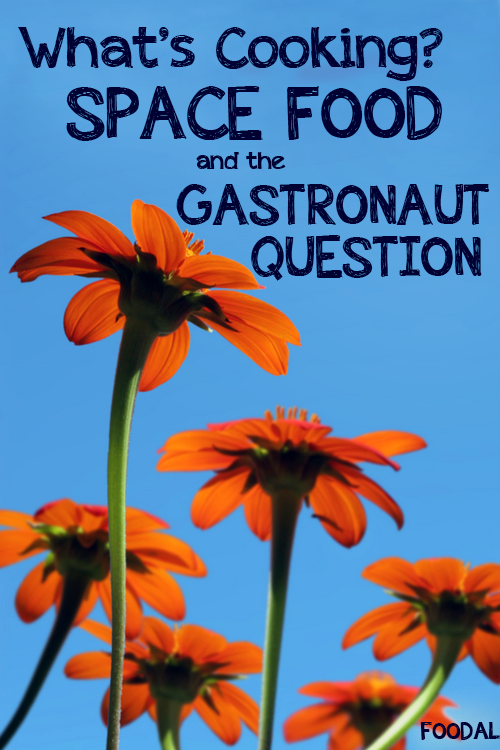
What I’m referring to (and that can be seen here) is the success that astronaut Scott Kelly and others on the International Space Station (ISS) recently had in their space gardening and farming program, when photos of a blooming zinnia were tweeted back to Earth.
Chances are that you’re not chowing down on zinnias on a regular basis (though they are an edible flower). But this special space blossom is actually the precursor, in the scientists’ onboard farming program, to growing tomatoes and other edible plants in the future.
All of thiGot s recent news brings me back to my own lifelong interest in space food. And I have so many questions about what the future might bring.
It’s pronounced GAS-tronomy
If you’re anything like me, and you had an interest in the space program as a kid, you probably wondered what they were eating up there.
I’ll get to that in a minute. But first, let’s quickly skip ahead about twenty years:
In graduate school, my major field of study was an area that’s still surprisingly rare today, considering our modern interest in everything food. As a result, I came armed with a quick response:
“No, not space food,” I’d say. “Gastronomy. Food studies.”
“Oh!” they’d reply, a brief glimmer of recognition passing over their faces, only to be replaced just as quickly by a befuddlement that seemed more likely to settle in for the long haul.
I’d go on to explain that I focused my studies in food policy and nutrition, as well as food marketing, heritage marketing, food history and food activism. Not necessarily space food, but instead, all aspects of food and its greater meaning in our lives.
My fellow students and I took a holistic look at the food system and the cultural meanings of food, using it as the lens through which we studied various subjects across disciplines.
This is where I usually insert my own imagined visual humor, envisioning myself holding up lenses of various food items to my eye and glancing through them to see the world in a new way: a paper-thin slice of prosciutto, a chocolate lace cookie filled with holes, a spun sugar candy gossamer…

Food reveals so much about who we are, what we enjoy, and what we care about, as individuals and as a society. But, back to the space program!
Putting it all together
In the three years or so since I earned my master’s degree, I’ve found my mind wandering back to the idea of “astronomy + food,” and the development of good eats for space travellers.
As the conditions on our own planet seem to grow increasingly dire by the day, as we wonder about the future of farming and ponder the fragility of our environment here on Earth, maybe space is where it’s at.
But what will we eat?
To begin to answer this question, I looked first to the history of food in the space program.
A time when taste was off the menu
NASA’s culinary options (as well as those provided by the Russians, Chinese, French, Italians, and others) started out – at least in part – with jet pilot food, military rations, and MREs (or Meals, Ready to Eat) in mind.
First, the food had to be non-perishable, and devoid of any need for cooking over an open flame, since this was impossible in space.
It also had to be high in nutrients, giving astronauts everything they’d need to survive (and possibly even thrive?), with the added features of both being able to get the job of eating done quickly, and providing adequate sustenance in a tiny package.
Illness, stomach upset, and differences in bodily function in space were also taken into account, when nutrition scientists and others were designing food for astronauts.
The food had to be consumable in zero gravity too, something no Earth soldier had ever experienced. And any necessary preparation would have to occur in zero gravity as well.
This was a lot to deal with. To say the least, function came before form. Deliciousness was basically off the table (and there weren’t any tables in space anyway).
Taste of home
Something that’s come to light more often today in articles about space food than in the past is the nostalgia for a home cooked meal, and the possibility of designing foods and ingredients that can be used in space to make food that really resembles, well, food.
So often, these items are liquids and pastes, packed into vacuum-sealed bags or tubes – not exactly appetizing.
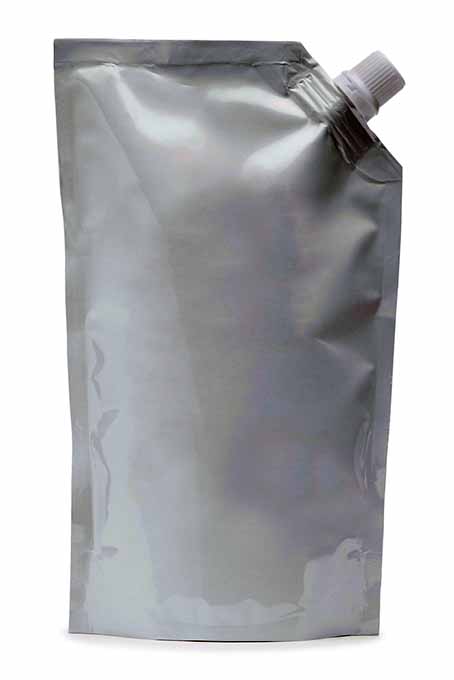
Plus, even when traveling in an airplane, our sense of taste is dulled. So, one would imagine, travelling on a space shuttle or living on the ISS (or maybe even a colony in space, someday) would have an even more extreme effect.
But astronauts have always missed homemade foods when they’re in space.
In fact, this is something that hopeful future travelers to Mars are actually planning for today. In an interview with food writer Jessica Franken, LA-based customer support manager and actor Sue Ann Pien, a member of the Mars One Space Program, said her perfect last day on Earth would involve eating all of the foods that she probably wouldn’t get another chance to, ever again (1).
Can you imaging giving up all of your favorite foods, forever?
Like soldiers stationed abroad, or immigrants to a new country, the foods of home are often what we miss the most. And these feelings of nostalgia tend to stick with us for life.
Cooking in zero-G
When you know you’re going to be spending a long time away from home, you probably do your best to pack little reminders and comforting items, and plan activities that can at least mentally take you back to the place that you’re used to.
Astronaut Sandra Magnus values the experience of cooking and sharing a meal with others, and she’s particularly interested in honing her skills as a zero gravity chef.
Magnus has learned, through a lot of trial and error, that duct tape and plastic bags will take you far. Cooking is so different than what we’re used to here on Earth, when you suddenly need to worry about your food floating away on its own.
You can’t mix ingredients in a bowl or chop on a cutting board. But bags and tape can help with sorting, mixing, and holding things in place.
Simple pleasures
When resources are in short supply and a variety of choices just aren’t available, many of us will adapt our diets, or return to old standbys.
It may come as no surprise that one of the best-loved space foods among astronauts, for the past couple of decades at least, is the humble tortilla.
Why? A NASA piece on this subject offers an explanation: it’s mainly because they’re not crumbly like bread, and they may be stored for long periods without any need for rehydration.
Plus, you can spread all kinds of things on them, like hot sauce or peanut butter, and they don’t taste all that different in space than they do here on the ground. Yum!
Is farming really in our future?
Of course, making our own meals and doing a little culinary gardening in space is only a small-scale approximation of what would be required, if colonizing other planets became a reality.
In a Lucky Peach feature written by Aaron Thier earlier this year, the future of eating on Mars is examined, with two possible outcomes. Basically, we could be shipping shelf-stable dry goods to fuel a colony, or we could learn to grow our own.
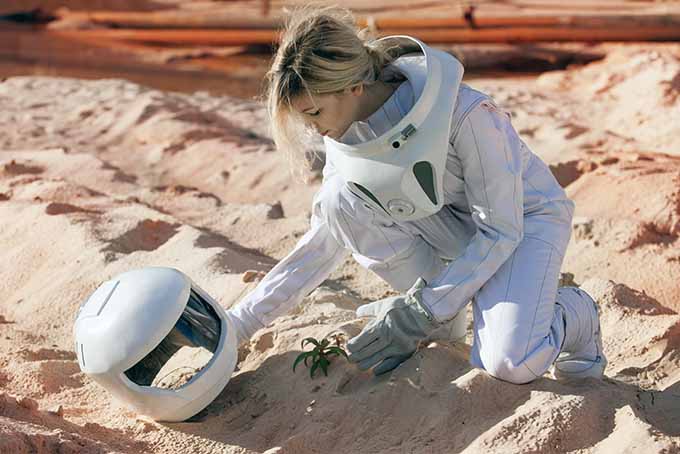
As Thier points out, though gardening on Mars could find a basis in the efforts that are taking place today on the ISS, growing practices would still require a lot of adjustment in comparison to what we’re used to here on the home planet, and what scientists are learning in zero gravity.
Everything from differences in the atmosphere and climate to reduced gravity and increased exposure to radiation on the red planet would need to be accounted for, not to mention figuring out how to fit the materials to build greenhouses and other necessary equipment into the payload allowance.
And that’s just the tip of the iceberg when it comes to the countless variables involved, including the potential for error and any unexpected outcomes.
The idea of someday growing food on Mars is certainly nothing new. I remember, when I was six or seven, a day when my dad came home talking about a story he’d seen in the news (or maybe it was actually a story from back when he was a child himself), in which we were going to “turn the red planet green.”
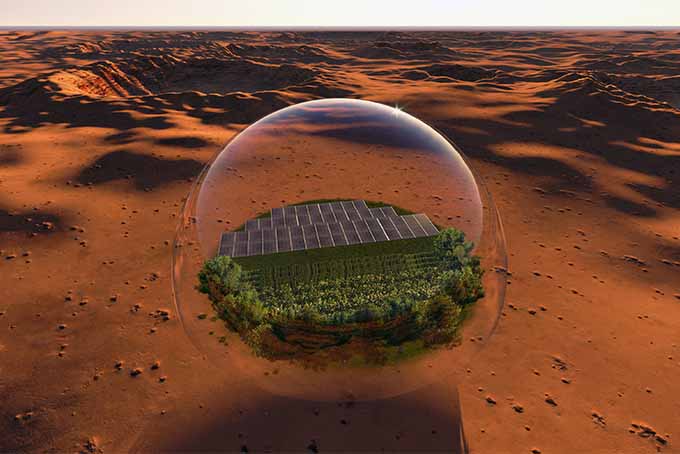
Sure, we’ve seen images from space that show new evidence that there’s water on Mars, too. But it’s an exceedingly complicated situation, and we’re just not ready yet to hop on our space tractors and go.
Then again, as Thier says, even though a mission of this sort might not be reasonable, there’s something in our DNA that compels us to go, and only time will tell what the future brings.
A return to the past
I began this piece with a mention of my own childhood interest in zero-gravity non-Earth food, and I will bring us back to that now:
My own first foray into the topic of space gastronomy was on a visit to the Kennedy Space Center in Cape Canaveral, Florida.
There, in the gift shop, my brother and I spotted the silver pouches of astronaut ice cream. And we wanted them to be ours.
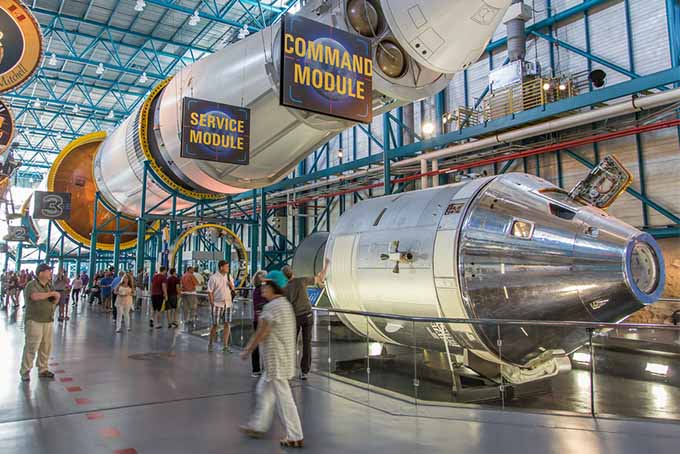
Upon tearing open the foil and eagerly placing a square on each of our tongues, excited anticipation turned to disappointment.
Though sweet, they were a lot like Styrofoam that (thankfully) quickly dissolved, and I can’t remember much about the flavor otherwise. The Dip n’ Dots that we ate outside in the afternoon sunshine on that same trip to Kennedy were much better.
I wondered then and have continued to wonder for years, on visits to various specialty toy boutiques and museum shops, why astronaut ice cream was the only item available for purchase in those ready-to-eat pouches.
Many times I have found myself looking through bins and piles of the same Neapolitan flavor (with gradually decreasing vigor, as the years went by), hoping to sample something other than this near-vile approximation of one of my favorite desserts, that real scientists in space also ate. I never found anything.

Though military MREs are available for civilian purchase on the internet – sold mainly to apocalypse-focused survivalists, natural disaster pre-planners and a few curious foodies – NASA-made items (or carefully branded approximations) are simply unavailable.
I could venture a guess at various possible explanations for this, but the most obvious is simply that NASA essentially chose, several decades ago, to cast aside or ignore the very human need for satisfying food, in favor of a more scientifically-minded focus on the mission at hand.
What’s your pleasure, spaceman?
It seems like, at least back in the early days of the space program, the issue of weight was the closest to the front of everyone’s minds, followed by nutrition. Enjoyment was barely an afterthought.
In Jane Levi’s “The Rise of the Gastronaut,” quoting another source, she says, “One researcher in the late 1960s commented dismissively that “Interviews with each astronaut regarding his food likes and dislikes have proved to be of little value”” (2).
Read Jane Levi’s piece and other fabulous writings in “food,” edited by John Knechtel and available for sale on Amazon.
This is really saying something, when it comes to our priorities related to human space travel. We need to eat, every day. If food is merely an afterthought, maybe we’d be better off just sending robots.
Fortunately, this thinking has finally begun to change. Quoting another source, Levi says, “Only in the last ten years have U.S. nutritionists stated categorically that, “Highly acceptable foods can play a primary role in reducing the stress of prolonged space missions.””
Travelling in space isn’t exactly the easiest thing for an Earth person to do, and it’s already hard enough to deal with zero gravity, lack of privacy, homesickness, changes in normal bodily functions, and so on. Having the opportunity to snack on something that’s actually enjoyable once in a while, or maybe even to eat a real meal with one’s fellow travelers, wouldn’t be the worst thing.
And that’s where tortillas come in, apparently, and cooking in bags. And even international cuisine.
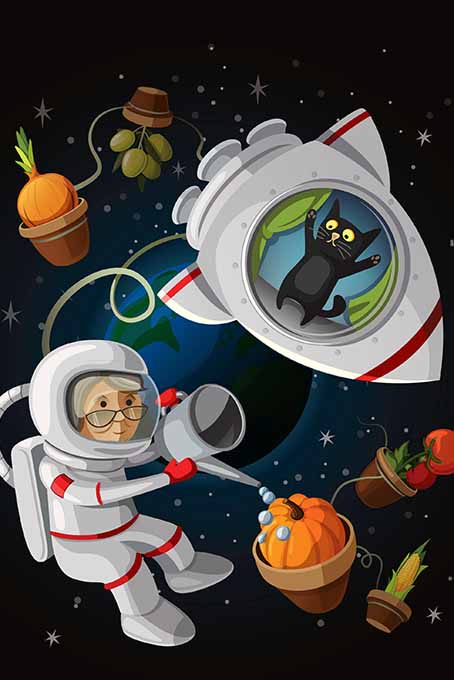
There’s more on these topics to come, but first: Does it surprise you that Americans who get to travel beyond the confines of our home planet seem to be the last ones to the good eats party?
The truth is, space food isn’t all bad.
The Russian cosmonauts were on top of the situation quite awhile before our own U.S. scientists. Levi quotes a line from “Psychology and Space” that reads, “Even in a short flight, tasty, favorite dishes can provide the astronauts with relaxation during their strenuous work.” Imagine that!
While our astronauts were choking down space cubes, the cosmonauts were eating fresh bread and salami, with a vacuum to suck up the crumbs.
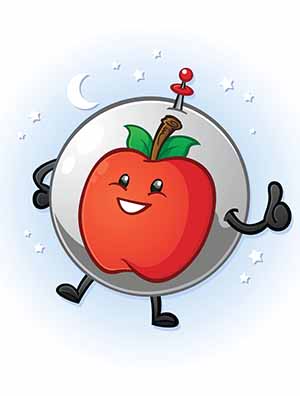 Russians were also the first to figure out how to heat their food, and they developed ways of refrigerating and transporting fresh produce, too. Finally, some real food!
Russians were also the first to figure out how to heat their food, and they developed ways of refrigerating and transporting fresh produce, too. Finally, some real food!
What the astronauts really wanted on board back then were TV dinners and comfort food, and the experts did finally start to figure out how to make that a possibility, by the end of the ‘60s.
The same is true for military MREs today, which feature well known “home cooked” flavors and popular items like pizza (though, admittedly, most of these U.S.-made options are still a far cry from the real thing in terms of taste, texture, and general palatability).
But homegrown fruits and vegetables? They weren’t even on the NASA scientists’ radar in those days.
Flavorful fare from around the globe
Of course, according to Levi, cosmonauts on Mir have been eating space-grown plants like onions for awhile now. And those TV dinners paled in comparison to the pre-made options various others brought with them to the space station, which served as tasty reflections of their own unique cultures and cuisines.
French astronauts brought gourmet food like duck confit and lobster. And the Chinese scientists brought pre-made dishes like shredded pork with garlic, and Szechuan chicken. My mouth is watering just thinking about it.
Maybe the core of the problem when it came to NASA’s culinary choices was that a national cuisine doesn’t really exist in the U.S. The strongest symbol of food culture that the greatest number of us can agree on is probably our unified love affair with processed, packaged convenience foods.
Looks like our space program participants have a lot of catching up to do.
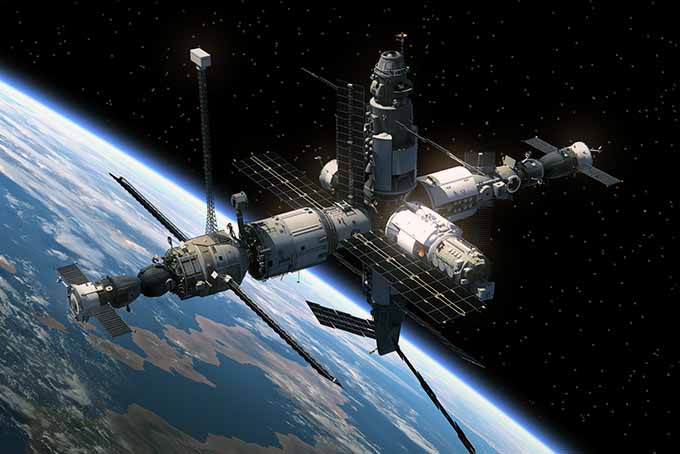
Despite the apparent advances of scientists from other nations in this area, there’s still a long way to go. Levi says, “Throughout most of its history, space food has proved to be a technical success and a culinary failure. In the future, as interplanetary travelers themselves take control of the farm as well as the kitchen, a new space gastronomy worthy of the name may emerge.”
But what does “real food” mean in space? Well, we’re still figuring that out.
Space gardening today
According to Mika McKinnon at Gizmodo, that zinnia that I mentioned at the top of the article wasn’t actually the first flower grown in space – astronauts have been growing them for decades, and this piece claims the first bloomed back in 1993.
Nonetheless, the photo of the blossom taken in January 2016 depicted the first grown by this particular astronaut, as part of a program conducted by the “Veggie Team” that is currently working in the ISS vegetable plant growth facility.
A red variety of romaine lettuce was the first edible item harvested there, back in 2014. Some plants died during their first run, but the next crop was ready to go.
This wasn’t just a scientific achievement. It was a gold star on the culinary accomplishments chart that we humans have proudly posted on the front of that cosmic fridge in the sky, marking a time in history when yes, salad was in fact a meal (and simultaneously an amuse-bouche to hint at things to come?), and the crew got to enjoy that space-grown meal together.
As Science Daily’s coverage of this moment states, “When the second batch of lettuce was harvested in August, and astronauts were allowed to eat the fruits of their labor, they gathered and shared the produce with international partners on the station.” It was like the first Thanksgiving, bringing all of the people together, and fresh space produce was had and enjoyed by all.
According to the planned progression of this program, zinnias were up next. This is because they’re more difficult to grow than lettuce, referred to on the NASA website as “a good precursor to a tomato plant.” Chinese cabbage and dwarf tomatoes are up next.
The bottom line? Farming is what you need to take a campsite to the next level, and make it into a homestead.
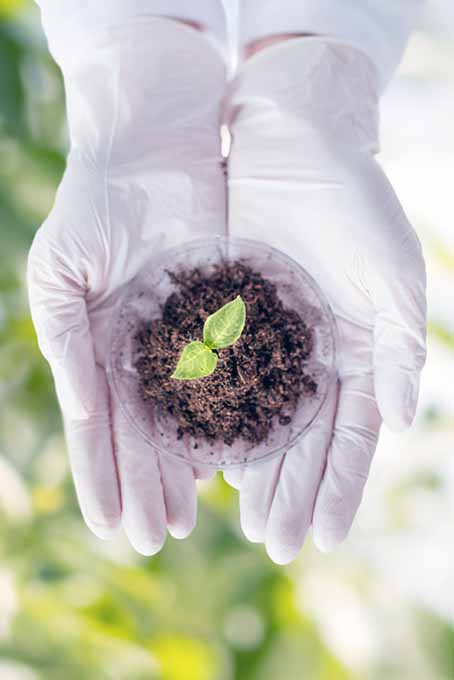
If we really are going to be living on Mars (or figuring out space colonization via travel to other planets and star systems at the speed of light, a la “Interstellar” and the creations of countless sci-fi authors and filmmakers, NASA fans, and people of all ages who have possessed imaginations since the 1960s, or the 1800s, or perhaps for all of human history, depending on whom you ask), then we will need to figure out how to grow our own food first.
Or, at least that looks like our top requirement, according to what’s en vogue in the food world today.
Food fads for space explorers
Jane Levi explains, also in the piece mentioned above, how meals developed for astronauts actually reflect changes in food culture on our own planet, from one decade to the next.
It’s not just about advances in food packaging technology or farming techniques. Rather, the spark that drives these new experiments and discoveries lies in our own Earthling interests in packaged convenience foods one day, or homegrown whole foods the next.
According to Levi (quoting Yuri Gagarin and Vladimir Lebedev’s book, “Psycholoy and Space”), the “first human meal in space” consisted of some sort of puree, a meat and liver pate, and black currant juice, all eaten and drunk out of tubes. Before this meal, scientists weren’t even sure whether eating in space would be possible.
Want to check out “Psychology and Space” for yourself? Find it here, on Amazon.
As it turns out, we can eat everywhere. Upside-down, under water, in space… Figures, doesn’t it?
Levi says tube-based foods like these were actually first developed for fighter pilots. Cubes of food, as well as items in cans and pouches, were developed later.
The varieties and flavors of the items selected are unique to the time and place in which they were manufactured – though they’re not entirely unavailable, you won’t find a lot of black currant juice and liver pate on menus around the U.S. today.
And, you know, everybody loves pouch food, right?
Yeah, no they don’t. Wrong.
Sure, we still live in a convenience food culture, but these factory-prepared items were the product of a different time, when the future of food meant something different.
In 2016, many of us eat chicken tikka masala out of a pouch at least once in awhile. But every day?
If you claim to love this type of food more than any other, particularly a freshly made alternative, I have to say I am skeptical.
I grew up eating canned peaches, I understand the nostalgia factor involved, and I have at least as much fondness for them as the next gal.
But in comparison to a ripe, fresh peach, dripping down your chin as you take that first sweet bite? I definitely choose the fresh one.
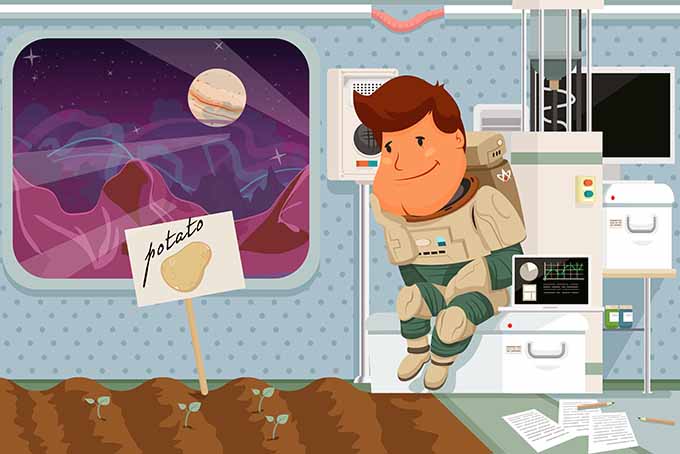
Though the Jetsons seemed super satisfied with their convenient cube-shaped meals, the reality of these space pellets was nothing like the other culinary pop cultural reference that immediately comes to mind: Violet Beauregarde’s enjoyment of a stick of Three-Course Dinner Chewing Gum at Willy Wonka’s chocolate factory.
(If you’ll reach back into the memory banks for a moment, you’ll probably remember that this particular taste test didn’t end well. Violet was transformed into a human-sized blueberry – ready to pop – and the Oompa Loompas carted her away.)
As Levi says, “Now, as missions lasting years are being contemplated, space food is set to launch into a new phase that emphasizes self-sufficiency. Mirroring current earthly concerns about sustainable agriculture and local produce, onboard food production will be an essential component on the journey to Mars.”
Mars is more than 30 million miles away, and it would take future colonists more than six months just to get there, at least based on the space travel technology that we currently have. That means those on board will need a lot of trail mix and tortillas, and a lot of space lettuce for the trip, plus supplies to get growing and grubbing once they arrive.
As I write this, on HI-SEAS (or the Hawaii Space Exploration Analog and Simulation) Mission 4, a simulator program for future Mars missions, Crew Commander Carmel Johnston is growing chard, and posting pictures tagged with #spacefood to Twitter.
Advances in technology paired with our ever-evolving knowledge of human nutrition have led us to this place where space farming is a priority, and perhaps for the first time, a viable possibility.

Someday, the future of gastronomy might actually be one hundred percent about space food. For now, I guess we’ll just have to wait and see.
Can you remember your first taste of space ice cream? What foods would you miss the most if you traveled to outer space, and what are your predictions for the future of astronaut food? Tell me all about it in the comments!
Sources:
(1): Franken, Jessica. “Meet the Martians: Five Women from the Mars One Space Program Share Their Thoughts on Leaving Earth Forever.” Winter 2016. https://bitchmedia.org/issue/69
(2): Levi, Jane. “The Rise of the Gastronaut.” food. Ed. by John Knechtel. MIT Press, Cambridge, MA. 2008.
Photo credits: Shutterstock.
About Allison Sidhu
Allison M. Sidhu is a culinary enthusiast from southeastern Pennsylvania who has returned to Philly after a seven-year sojourn to sunny LA. She loves exploring the local restaurant and bar scene with her best buds. She holds a BA in English literature from Swarthmore College and an MA in gastronomy from Boston University. When she’s not in the kitchen whipping up something tasty (or listening to the latest food podcasts while she does the dishes!) you’ll probably find Allison tapping away at her keyboard, chilling in the garden, curled up with a good book (or ready to dominate with controller in hand in front of the latest video game) on the couch, or devouring a dollar dog and crab fries at the Phillies game.




Gosh, I wish I could say I had eaten space ice cream, it sounds wonderful! Unfortunately interstellar efforts in the UK are only just getting off the ground (pardon the pun), but it is becoming more popular and widely recognised in the public eye due to our newest astronaut, Major Tim Peake, who is currently aboard the International Space Station!
As for the future of space food, have you heard of Soylent? An engineering student came up with it a couple of years ago as a way to get all of his required calories and nutrients from a kind of powder mixed with water (the guy really did not want to cook!). He visited and revisited the formula until he finally came across one which delivers a calorific, highly nutritious diet without the need for any other foods. He said it made him more alert and feel generally a lot better. So perhaps this powder might be the future of food aboard our starships? Unfortunately it is largely flavourless and it would be the only thing to eat which to me sounds like a nightmare!
Thanks for your comment, DangerSuit. I just sent a link to Major Tim Peake via Twitter (Hello from Earth, if you’re reading this! Please let us know what you’ve been eating on the ISS!)
I have heard of Soylent, and that is exactly the kind of thing that I am talking about- though it’s highly nutritive, it lacks flavor, texture, and novelty. Perhaps even more importantly, it is not freshly grown, requires the bare minimum of prep, and is not meant to be shared and enjoyed with others. I’m sure it gets the job done in terms of survival, but I doubt that anyone will ever wax nostalgic about it.
If that was all we had to eat, here or on a space colony in the future, I don’t know what I’d do! Start figuring out how to grow some real food, probably.
Firstly, I know this is off topic but I love the writing style of this article! In particular the puns at the beginning. Moving on, the first time I had real astronaut ice cream was at the Space Center in Houston. I was 15 or 16 (which I now realize was ten years ago, Jesus), and we had gone to Texas for a family trip, it was also my first time on an airplane. I remember being surprised by how creamy it was as it dissolved, but disappointed in the overall experience, As for the rest, I think farming in space is fascinating, it baffles me how close we are to the future that the 50s and 60s predicted. I am forced to disagree that America has no real cuisine, though. The fact that we adopt from other cultures and make them our own is part of what I love about living in America. I love that I can get a burrito and pad thai on the same block, and I have to say that America really excels at comfort food. This article was enjoyable, and it really made me think, which is an achievement for a food blog.
Thanks so much for your comment, cnt422, and for your kind words.
What a coincidence- my visit to Kennedy was also part of a trip that involved my first time on an airplane. But it was more like 21 years ago for me!
I’d love to continue the conversation about defining an American cuisine– great topic for a future post!
Thank you for the enlightening read Allison! Its pretty amazing what we have achieved so far in this topic. To think that astronauts used to have to consume pastes and cans of what looks like dog food. I know MRE’s aren’t made in space, but I’ve noticed a definite improvement from the past to the most recent ones. Doesn’t reading this make us curious about what the future holds? I mean someday we might be selected to go into space and grow our own food and cook it! As much as this appeals to me, the idea of my food floating away as I prep it does not seem like something fun.
MREs are waaayyyy better than used to be. Anyone else remember the freezed dried pork patty (Circa early 90s)? OMG…I’m not a picky eater but those were bad enough to make a pit bull gag. And this was before the heater bags were invented.
The newest ones aren’t bad at all. Ate them for about 3 months straight in OIF 1 in 2003 with the exception of the occasional lamb kabob off the street.
Oddly enough I just read an article the other day saying that they didn’t think astronauts actually ate the space ice cream, it said they didn’t like the taste so they made it into a souvenir. Have you heard any more about that?
This was a really fascinating article though! That makes perfect sense about tortillas, and I think that is why they are such a great pantry staple here on earth too. They keep well and are so versatile, I will buy them instead of bread all the time. Really fascinating info about space farming too, it’s definitely interesting as we look into more sustainable foods.
I’ve recently seen the Martian movie with Matt Damon and was wondering if the whole ‘potatoes on Mars’ thing is realistic. I guess it’s more possible than I thought 🙂
I really appreciated this article, it was really unexpected from your blog.
My favorite part is the one about salad being a culinary achievement.
Humans are incredible… not only are we going to Mars, but also planting Earth vegetables there!
Thanks, Elfprincess! I recently saw Interstellar and rewatched Contact (both starring Matthew McConaughey, something I’d forgotten) but I haven’t had a chance to see the one you mentioned yet. It’s at the top of my list- must be spending too much time writing and thinking about (and prepping and cooking and enjoying…) new and exciting things to eat!
Really interesting and also informative article! It was fun to read and at the same time I learned some history about space exploration! What I really can’t wait for is when we do turn mars green per say, we will get new varieties of local produce from mars, hopefully, as space travel advances faster and faster as time goes by, who knows what other produce and culinary possibilities we might find on other colonizable planets? (A bit of a wild idea I know ahah)
My aunt got my kids space ice cream for Christmas and they ate it up super fast. I was a bit annoyed that I didn’t get to try it, but now I’m glad I didn’t. In movies they make growing food in space seem simple but I’m sure that in the real world it is quite complex.
I would find it very hard to live on limited food items, especially if they didn’t taste that great. It sounds like it could cause mental health issues very easily. Food is one of the easiest ways to boost your mood. To never eat for pleasure but only for sustenance explains to me why astronauts are always so thin when they come back to earth.
True story…I went to space camp as a kid via an essay based scholarship that I won. Space Camp the movie was all the rage (at least those in the 8 -12 years old bracket) at the time.
Anyhow, I really liked the freeze dried ice cream when we sampled it at the facility in Huntsville, AL.
When I think about all the advances in food and cooking that have already come from space programs, I wonder about what else will come. So many things we take for granted today are available as side projects developed from going to space.
So true, nytegeek, and I couldn’t agree more. Can’t wait to see what the future brings!
Thanks for the memories. I had my first taste of freeze-dried ice cream as a kid in the 70s. Sweet as it was, there was no getting past the squeaky styrofoam texture. We pretended to like it because it was the cool food of the Apollo 11 astronauts. We’ve come a long way from the boil-in-a-bag meals of my youth, when ketchup counted as a vegetable on the school lunch platter. Cultivating and consuming “real” food in space is very exciting!
Coooooooooooooooooool! It’s nice to hear that there have been some advancements on the food issue for the astronauts 🙂 I can’t imagine myself not being able to eat tasty food for a very long period of time, so I give all my regards to those astronauts who are willing to not eat tasty food and not be with their family for such long period of time in order to expand our knowledge of the galaxy and consequently help the planet to improve its technology, in one way or another 🙂
This is so interesting, if there are people are considering to move out of Earth and going to Mars, they have probably thought about the food part, and maybe is not that possible today to achieve such thing as planting our own food there, but maybe in a few years it will be possible, maybe not really?
And I actually have heard about the lettuce that was processed on space, there’s a video out there of it, and to be honest, it doesn’t seem to be the most delicious thing ever, but you know, as you’ve said, that’s an achievement.
Your article shows that the topic can be brought closer to everyone.